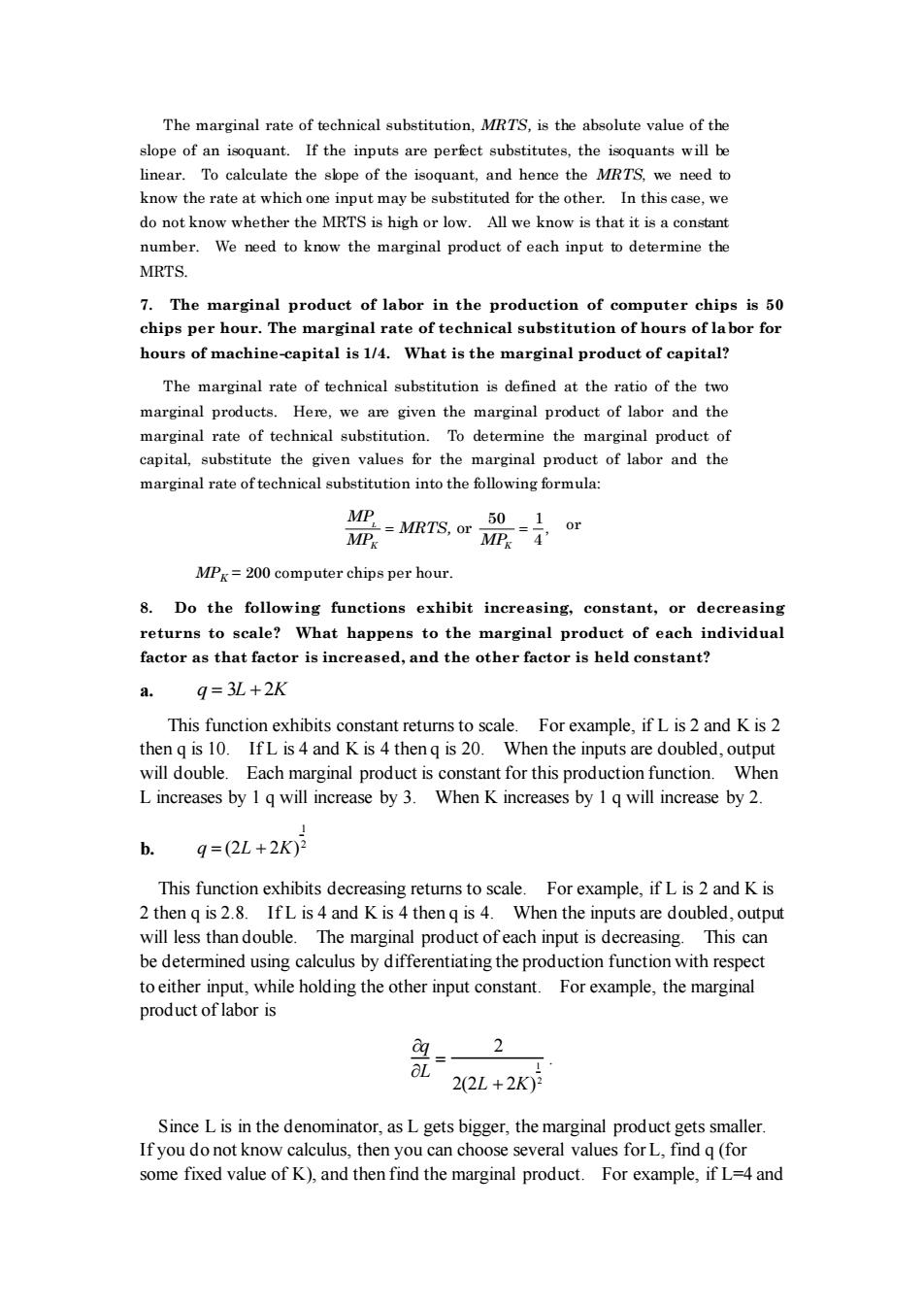正在加载图片...

The marginal rate of technical substitution.MRTS.is the absolute value of the slope of an.If the inputs are perfct substitutes,the quantswill b linear.To caleulate the sbpe of the isoquant,and hence the MRTSwe needto know the rate at which one input may be substituted for the other.In this case,we do not know whether the MRTS is high or low.All we know is that it is a constant number.We need to know the marginal product of each input to determine the MRTS. 7.The mar ginal product of labor in the is 50 chips per r ho r.The arginal r of technical urs oflabor for hours of machine-capital is 1/4.What is the marginal product of capital? The marginal rate of technical substitution is defined at the ratio of the tw marginal products.Here,we are given the marginal product of labor and the marginal rate of technical substitution.To determine the marginal product of and the } or MPK=200 computer chips per hour. 8.Do the following functions exhibit increasing,constant,or decreasing returns to scale?What happens to the marginal product of each individual factor as that factor is increased,and the other factor is held constant? g=3L+2K This function exhibits onant scale For example.if s2andKis the g is 10.IfL is 4 and K is 4 ther w double. 9s20 When the inpu doubled.o p Each marginal product is constant for this production function. L increases by I q will increase by 3.When K increases by I q will increase by 2. b. 9=(2L+2K月 This function exhibits decreasing returns to scale.For example,if L is 2 and K is 2 then q is 2.8.IfL is 4 and K is 4 thenq is 4.When the inputs are doubled,output will less than double.The marginal asing This can be determined using calculus by differentiating the production functior with respect to either input,while holding the other input constant.For example,the marginal product of labor is 2 d2L+20 Since L is in the de product gets smaller If you do not kr now ca Iculus nen you can choo e severa I values forL,find q(fo some fixed value of K),and then find the marginal product.For example,if L=4 and The marginal rate of technical substitution, MRTS, is the absolute value of the slope of an isoquant. If the inputs are perfect substitutes, the isoquants will be linear. To calculate the slope of the isoquant, and hence the MRTS, we need to know the rate at which one input may be substituted for the other. In this case, we do not know whether the MRTS is high or low. All we know is that it is a constant number. We need to know the marginal product of each input to determine the MRTS. 7. The marginal product of labor in the production of computer chips is 50 chips per hour. The marginal rate of technical substitution of hours of labor for hours of machine-capital is 1/4. What is the marginal product of capital? The marginal rate of technical substitution is defined at the ratio of the two marginal products. Here, we are given the marginal product of labor and the marginal rate of technical substitution. To determine the marginal product of capital, substitute the given values for the marginal product of labor and the marginal rate of technical substitution into the following formula: MP MP MRTS, MP L K K = or = 50 1 4 , or MPK = 200 computer chips per hour. 8. Do the following functions exhibit increasing, constant, or decreasing returns to scale? What happens to the marginal product of each individual factor as that factor is increased, and the other factor is held constant? a. q = 3L + 2K This function exhibits constant returns to scale. For example, if L is 2 and K is 2 then q is 10. If L is 4 and K is 4 then q is 20. When the inputs are doubled, output will double. Each marginal product is constant for this production function. When L increases by 1 q will increase by 3. When K increases by 1 q will increase by 2. b. q = (2L + 2K) 1 2 This function exhibits decreasing returns to scale. For example, if L is 2 and K is 2 then q is 2.8. If L is 4 and K is 4 then q is 4. When the inputs are doubled, output will less than double. The marginal product of each input is decreasing. This can be determined using calculus by differentiating the production function with respect to either input, while holding the other input constant. For example, the marginal product of labor is q L = 2 2(2L + 2K) 1 2 . Since L is in the denominator, as L gets bigger, the marginal product gets smaller. If you do not know calculus, then you can choose several values for L, find q (for some fixed value of K), and then find the marginal product. For example, if L=4 and